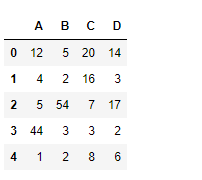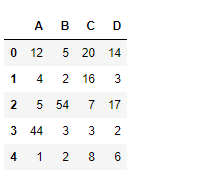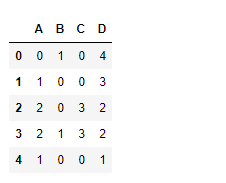Python Pandas dataframe.mod()
Python是一种进行数据分析的伟大语言,主要是因为以数据为中心的Python软件包的奇妙生态系统。Pandas就是这些包中的一个,使导入和分析数据变得更加容易。
Pandas dataframe.mod()函数返回dataframe和其他元素的模数(二进制运算符mod)。这个函数本质上与Dataframe % other相同,但支持用fill_value来替代其中一个输入的缺失数据。这个函数可以用于系列或数据框架。
语法:
DataFrame.mod(other, axis=’columns’, level=None, fill_value=None)
参数 :
其他:系列,数据框架,或常数
axis:对于系列输入,axis要与系列的索引相匹配。
level :跨层广播,与通过的MultiIndex层的索引值相匹配。
fill_value : 在计算前用这个值填充现有的缺失(NaN)值,以及成功的DataFrame对齐所需的任何新元素。如果两个对应的DataFrame位置的数据都缺失,那么结果将是缺失。
返回 : result : DataFrame
例子#1:使用mod()函数找到数据框中每个值与常数的模数。
# importing pandas as pd
import pandas as pd
# Creating the dataframe
df = pd.DataFrame({"A":[12, 4, 5, 44, 1],
"B":[5, 2, 54, 3, 2],
"C":[20, 16, 7, 3, 8],
"D":[14, 3, 17, 2, 6]})
# Print the dataframe
df

让我们使用dataframe.mod()函数来寻找数据框的模数,其中有3个模数。
# find mod of dataframe values with 3
df.mod(3)
输出 :

例子2:使用mod()函数在列axis上用一个系列来寻找模数。
# importing pandas as pd
import pandas as pd
# Creating the dataframe
df = pd.DataFrame({"A":[12, 4, 5, 44, 1],
"B":[5, 2, 54, 3, 2],
"C":[20, 16, 7, 3, 8],
"D":[14, 3, 17, 2, 6]})
# Print the dataframe
df

我们来创建系列对象
# create a series
sr = pd.Series([3, 2, 4, 5])
# setting its column index similar to the dataframe
sr.index =["A", "B", "C", "D"]
# print the series
sr

让我们使用dataframe.mod()函数来寻找带有系列的dataframe的模数。
# find mod of dataframe values with series
# axis = 1 indicates column axis
df.mod(sr, axis = 1)
输出 :

 极客教程
极客教程